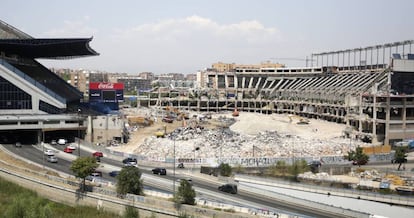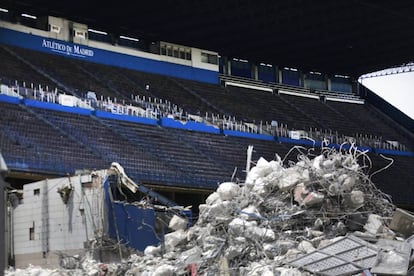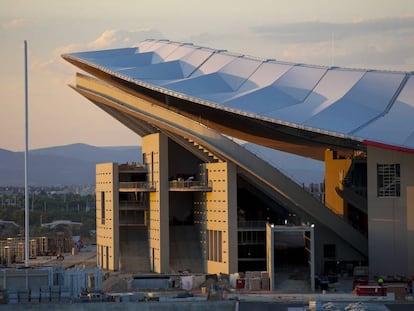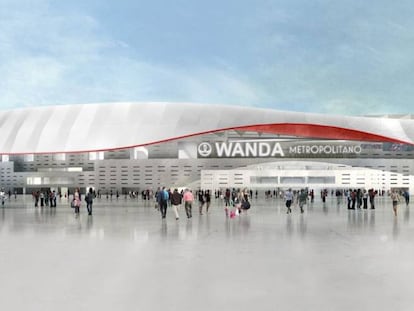Rest in pitch: How Atlético even took some of its dead supporters with it to its new stadium
At its former home, the club’s fans could opt to have their ashes kept in a columbarium under the stands. The demolition of the building, however, has meant they had to be moved

Rest in peace… Apart from Sundays when Atlético de Madrid are playing a soccer match. That was the last wish of fans who, from 2009 onward, could opt to have their ashes laid to rest in the bowels of the club’s iconic Vicente Calderón stadium. There were even some requests for the urns to be turned over on game days so that they would be facing the pitch, and still somehow take in all of the goals scored by their beloved club. The idea was a declaration of unconditional love toward a place in which fans wanted to remain until the death itself of the stadium itself – an agonizing process that entered its final stages in February as the full demolition of the building began.
Atlético created a columbarium measuring around 600 square meters and with room for 2,490 niches
Inaugurated in 1966 on the banks of Madrid’s Manzanares River, the nearly 55,000-seater stadium was home to the club until the end of the 2017 season, when it relocated to the newly built Wanda Metropolitan stadium in the northeast of the city. In 2007, the club, Madrid City Hall and Spanish beermaker Mahou, which owned a brewery nearby, signed a deal to rezone the land, which will be turned into a residential area. Legal wrangles saw the project delayed numerous times over the years, hence the demolition only getting underway earlier this year.
Under what was the south side of the stadium, Atlético created a columbarium measuring around 600 square meters and with room for 2,490 niches, the prices of which ranged from €1,500 to €4,000, depending on whether there was room for one, two or even three urns. Located in the former club gymnasium, there was also a chapel – all aimed at facilitating visits from relatives and friends during the 50 years that the niches could be occupied for.
The idea originated in the fact that many fans would scatter the ashes of their loved ones on soccer pitches, despite a complete lack of regulations covering such an activity. Giem Sports, the company that conceived the scheme, convinced not only Atlético to put it into place, but also Betis, Barcelona F.C. and Espanyol. They even widened the scope of the project, and secured contracts with racing circuits such as Montmeló, the Catalan track that has played host to Formula 1 and MotoGP races.

But Atleti was the first club to take the plunge. The walls of the former gym were converted into ceramic murals, featuring images of the club’s most glorious moments. Behind these walls were the ashes of its fans.
But the business, dubbed Vicente Calderón Memorial Space, never ended up working out the way it was supposed to. Only a tiny percentage of the niches were occupied in 2012. According to the last data that news agency EFE had access to in that year, there were barely 30 urns in there with 120 niches reserved – far from the 4,210 urns that could have been housed there.
The business, dubbed Vicente Calderón Memorial Space, never ended up working out the way it was supposed to
Years later, in 2016, Giem Sports had to suspend its payments and went into administration, leaving the future of its business up in the air. The firm’s former owner, Santiago Bach, ended up being accused of fraud by his partners and investors based on the project that he started at Barcelona F.C.’s stadium, the Camp Nou. The court probe included an investigation into the current chairman of Barcelona, Josep Maria Bartomeu, and the former director Toni Freixa. The case was eventually shelved.
“I imagine that if we are going to change [the columbarium] it will all have been dealt with already, with the permission of the families and everything,” said the current chairman of Atlético, Enrique Cerezo, back in December 2018 during the signing of an agreement between Madrid City Hall and Mahou San Miguel, which finally made way for the redevelopment project that had long been planned for the site.
While the ashes remained in the Calderón during the first year of the existence of Atlético’s new stadium, the Wanda Metropolitano, the start of the demolition work required the transfer of the remains, something that, the club has confirmed, has now been completed.
English version by Simon Hunter.
Tu suscripción se está usando en otro dispositivo
¿Quieres añadir otro usuario a tu suscripción?
Si continúas leyendo en este dispositivo, no se podrá leer en el otro.
FlechaTu suscripción se está usando en otro dispositivo y solo puedes acceder a EL PAÍS desde un dispositivo a la vez.
Si quieres compartir tu cuenta, cambia tu suscripción a la modalidad Premium, así podrás añadir otro usuario. Cada uno accederá con su propia cuenta de email, lo que os permitirá personalizar vuestra experiencia en EL PAÍS.
¿Tienes una suscripción de empresa? Accede aquí para contratar más cuentas.
En el caso de no saber quién está usando tu cuenta, te recomendamos cambiar tu contraseña aquí.
Si decides continuar compartiendo tu cuenta, este mensaje se mostrará en tu dispositivo y en el de la otra persona que está usando tu cuenta de forma indefinida, afectando a tu experiencia de lectura. Puedes consultar aquí los términos y condiciones de la suscripción digital.
More information
Últimas noticias
Most viewed
- Sinaloa Cartel war is taking its toll on Los Chapitos
- Reinhard Genzel, Nobel laureate in physics: ‘One-minute videos will never give you the truth’
- Oona Chaplin: ‘I told James Cameron that I was living in a treehouse and starting a permaculture project with a friend’
- Why the price of coffee has skyrocketed: from Brazilian plantations to specialty coffee houses
- David King, chemist: ‘There are scientists studying how to cool the planet; nobody should stop these experiments from happening’










































